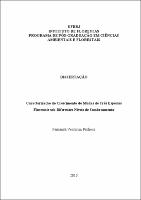Por favor, use este identificador para citar o enlazar este ítem:
http://rima110.im.ufrrj.br:8080/jspui/handle/20.500.14407/11834| metadata.dc.type: | Dissertação |
| Título : | Caracterização do crescimento de mudas de três espécies florestais sob diferentes níveis de sombreamento |
| Otros títulos : | Characterization of the growth of seedlings of three forest species under different shading levels. |
| metadata.dc.creator: | Pacheco, Fernanda Ventorim |
| metadata.dc.contributor.advisor1: | Pereira, Carlos Rodrigues |
| metadata.dc.contributor.advisor-co1: | Leles, Paulo Sérgio dos Santos |
| metadata.dc.contributor.referee1: | Dourado Neto, Durval |
| metadata.dc.contributor.referee2: | Macrae, Fernanda Reinert Thomé |
| metadata.dc.contributor.referee3: | Silva, Rogério Luiz da |
| metadata.dc.description.resumo: | A produção de mudas de essências florestais, seja com finalidade econômica ou conservacionista, depende de conhecimentos relacionados ao crescimento e desenvolvimento vegetal. O estudo do crescimento e desenvolvimento de uma planta, em diferentes condições ambientais, permite definir e aprimorar formas de cultivos mais adequadas. |Este trabalho teve como objetivo avaliar o desempenho de mudas de Schinus terebenthifolius (aroeira), Dalbergia nigra (jacarandá caviúna) e Chorisia speciosa (paineira) cultivadas em casas de vegetação sob 0%, 22%, 50%, 70%, 84% e 91% de sombreamento. Os parâmetros de crescimento analisados foram altura, diâmetro do colo, área foliar e massa seca total em função do sombreamento. Foram analisadas 24 mudas por espécie, sendo essas analisadas até os seus 90 dias após a emergência nos diferentes ambientes de sombra. As amostragens foram realizadas periodicamente, a cada dois dias no primeiro mês, a cada quatro dias no segundo e a cada oito dias no ultimo mês. S. terebenthifolius e C. speciosa tiveram o crescimento beneficiado nos tratamentos a 22 e 50% de sombra. Já as mudas de D. nigra se beneficiaram com os níveis intermediários de sombra (50, 70 e 84%). A partir dos resultados observa-se que S. terebenthifolius e C. speciosa em seu ambiente natural podem ser beneficiadas com a presença de clareiras, comportando-se como espécies secundárias iniciais. Assim pode ser sugerido o seu plantio a céu aberto ou em adensamento de capoeiras. Por outro lado, as mudas de D. nigra parecem ser mais favorecidas em dosséis fechados apresentando-se como uma espécie secundária tardia. O plantio dessa espécie, portanto, seria mais adequado para o enriquecimento de matas. Pode ser estabelecida uma ordem crescente de exigência a sombra na seguinte seqüência: S. terebenthifolius = Chorisia speciosa < D. nigra. |
| Resumen : | The production of seedlings of forest essences, with economical or conservationist purposes, depends on the knowledge of plant growth and development. The study of the growth and development of a plant, in different environmental conditions, allows to define and to improve more appropriate forms of cultivation. The objective of this study was to assess the development of seedlings of Schinus terebenthifolius (aroeira), Dalbergia nigra (jacarandá caviúna) and Chorisia speciosa (paineira) grown in green house under 0%, 22%, 50%, 70%, 84% and 91% of shading. The parameters used for growth evaluation were height, diameter of the base of the stem, leaf area and total drought mass in relation to the shade level. Were analyzed 24 seedlings by species, which were analyzed up to 90 days after the emergency under different shade levels. The samplings were carried out periodically, every other day in the first month, every four days in the second and every eight days in the last month. S. terebenthifolius and C. speciosa had their growth favored under 22 and 50% of shading. The seedlings of D. nigra were favored by intermediate levels of shadow (50, 70 and 84%). According with the results S. terebenthifolius and C. speciosa can be benefitted with the presence of gaps in their natural ambient, acting as secondary species. In this way these species can be used in plantations at open sky or in the enrichment of secondary forests. On the other hand, the seedlings of D. nigra seem to be more favored in closed canopies, acting as a late secondary species. The planting of this species, therefore, could be more appropriate for the enrichment of forests. An increasing order of shade demand could be established as follows: S. terebenthifolius = Chorisia speciosa < D. nigra. |
| Palabras clave : | espécies florestais sombreamento mudas radiação e necessidade de luz forest species shade seedlings radiation and light requirements |
| metadata.dc.subject.cnpq: | Recursos Florestais e Engenharia Florestal |
| metadata.dc.language: | por |
| metadata.dc.publisher.country: | Brasil |
| Editorial : | Universidade Federal Rural do Rio de Janeiro |
| metadata.dc.publisher.initials: | UFRRJ |
| metadata.dc.publisher.department: | Instituto de Florestas |
| metadata.dc.publisher.program: | Programa de Pós-Graduação em Ciências Ambientais e Florestais |
| Citación : | Pacheco, Fernanda Ventorim. Caracterização do crescimento de mudas de três espécies florestais sob diferentes níveis de sombreamento. 2010. [40 f.]. Dissertação (Programa de Pós-Graduação em Ciências Ambientais e Florestais) - Universidade Federal Rural do Rio de Janeiro, Seropédica. |
| metadata.dc.rights: | Acesso Aberto |
| URI : | https://rima.ufrrj.br/jspui/handle/20.500.14407/11834 |
| Fecha de publicación : | 24-mar-2010 |
| Aparece en las colecciones: | Mestrado em Ciências Ambientais e Florestais |
Se for cadastrado no RIMA, poderá receber informações por email.
Se ainda não tem uma conta, cadastre-se aqui!
Ficheros en este ítem:
| Fichero | Descripción | Tamaño | Formato | |
|---|---|---|---|---|
| 2010 - Fernanda Ventorim Pacheco.pdf | 2010 - Fernanda Ventorim Pacheco | 599.49 kB | Adobe PDF |  Visualizar/Abrir |
Los ítems de DSpace están protegidos por copyright, con todos los derechos reservados, a menos que se indique lo contrario.

